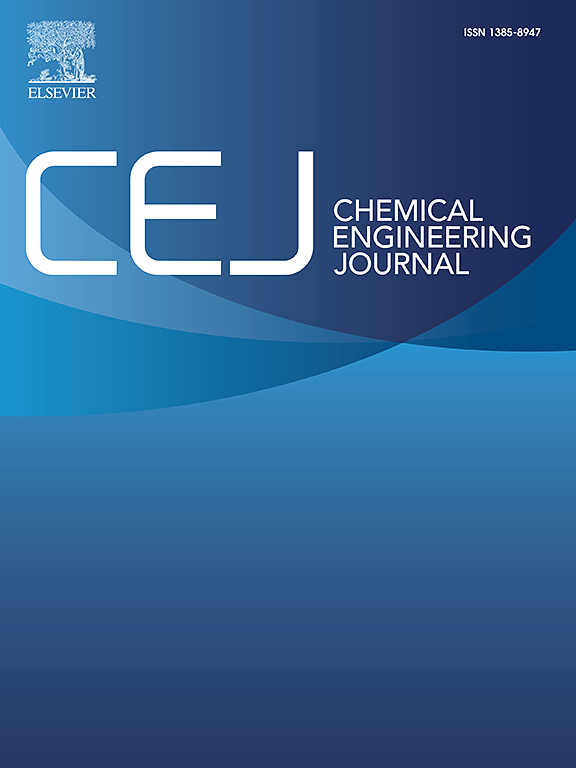增强 Ni3Fe 纳米合金中 Ni 的氧化重构,实现 5-羟甲基糠醛的高效电氧化
IF 13.3
1区 工程技术
Q1 ENGINEERING, CHEMICAL
引用次数: 0
摘要
本文提出了一种新型球磨-热解策略,用于制备高度分散的 Ni3Fe 纳米合金催化剂(Ni3Fe@NC),用于 5-hydroxymethylfurfural (HMF) 电氧化反应。Ni3Fe@NC 在 1.467 V vs RHE 的低电位条件下可产生 100 mA cm-2 的高电流密度,HMF 转化率超过 99.6%,2,5-呋喃二甲酸 (FDCA) 选择性为 97.1%,法拉第效率为 96.7%。理论计算、原位 EIS、准原位 XRD 和 XPS 均表明,掺杂铁优化了 Ni3Fe@NC 的电子结构,并调节了其 d 带中心、这不仅促进了 Ni3Fe@NC 重构形成高氧化活性的 Ni2+δ 和 Ni3+δ 物种,还降低了 HMFOR 过程中关键速率决定步骤(*5-羟甲基-2-呋喃羧酸 (HMFCA)→*5- 甲酰基-2-呋喃羧酸 (FFCA))的反应障碍。基于这项有趣的工作,我们提供了一种用于高效电氧化 HMF 的高分散纳米合金催化剂的简便宏观制备策略。本文章由计算机程序翻译,如有差异,请以英文原文为准。
Enhancing Ni oxidation reconstruction in Ni3Fe nanoalloy for efficient Electro-Oxidation of 5-Hydroxymethylfurfural
Herein, a novel ball milling-pyrolysis strategy was proposed for preparing a highly dispersed Ni3Fe nanoalloy catalyst (Ni3Fe@NC) used for 5-hydroxymethylfurfural (HMF) electro-oxidation reaction. The Ni3Fe@NC delivered a high current density of 100 mA cm−2 at a low potential of 1.467 V vs RHE, with a HMF conversion rate of over 99.6 %, 2,5-furan dicarboxylic acid (FDCA) selectivity of 97.1 % and a Faraday efficiency of 96.7 %. Theoretical calculations, in-situ EIS, quasi-in-situ XRD and XPS demonstrated that Fe-doping optimizes the electronic structure of Ni3Fe@NC and regulates its d-band center, which not only promoted the reconstruction of Ni3Fe@NC to form high-oxidation-activity Ni2+δ and Ni3+δ species but also reduced the reaction barrier of the key rate-determining step (*5-Hydroxymethyl-2-furancarboxylic acid (HMFCA)→*5-formyl-2-furancarboxylic acid (FFCA)) during HMFOR. Based on this interesting work, we provided a facile macroscopic preparation strategy on highly dispersed nanoalloy catalyst for efficient electro-oxidation of HMF.
求助全文
通过发布文献求助,成功后即可免费获取论文全文。
去求助
来源期刊

Chemical Engineering Journal
工程技术-工程:化工
CiteScore
21.70
自引率
9.30%
发文量
6781
审稿时长
2.4 months
期刊介绍:
The Chemical Engineering Journal is an international research journal that invites contributions of original and novel fundamental research. It aims to provide an international platform for presenting original fundamental research, interpretative reviews, and discussions on new developments in chemical engineering. The journal welcomes papers that describe novel theory and its practical application, as well as those that demonstrate the transfer of techniques from other disciplines. It also welcomes reports on carefully conducted experimental work that is soundly interpreted. The main focus of the journal is on original and rigorous research results that have broad significance. The Catalysis section within the Chemical Engineering Journal focuses specifically on Experimental and Theoretical studies in the fields of heterogeneous catalysis, molecular catalysis, and biocatalysis. These studies have industrial impact on various sectors such as chemicals, energy, materials, foods, healthcare, and environmental protection.
 求助内容:
求助内容: 应助结果提醒方式:
应助结果提醒方式:


